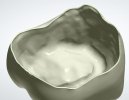C
Chrischung
Member
Full Member
- Messages
- 15
- Reaction score
- 0
I'm not sure. This doctor usually doesn't send those pictures.What did the original tooth look like?
It looks good from the occlusal view, but I can't tell you any more without the rest of the caseCan I get feedback for a design I did?
View attachment 40090
The adjacent teeth will always give you a clue on how detailed the occlusal anatomy should be.I'm not sure. This doctor usually doesn't send those pictures.
We'd take it easy on you ...no really we would...Occlusally, maybe just a little to pinched together, maybe also a bit to steep of anatomy compared to the others (making it looked more pinched). I would bring the central dissectional area up just a bit, to help flatten out the occlusal table, if the opposing allows for it. How does the opposing move through excursions when you check it with a 3Shape articulator?
All in all it looks pretty good from that view. If I were to post one of my #15s, I'm sure I'd get plenty of helpful feedback, too


The more nit-pickier, the better. I really appreciate it.Note to be a nit-picky lab tech… maybe the central dissectional groove could be moved a bit buccally and form the mesial fossa to receive the opposing cusp. Looks like the opposing cusp is hitting the mesio-buccal cusp ridge in a weird spot?
Is the temp impression before the doctor preps the tooth?The adjacent teeth will always give you a clue on how detailed the occlusal anatomy should be.
When you start designing crowns from an IOS, you can use the preprep scan to copy the original tooth with any improvements.
What you could do is ask for the temp impression which you could pour, scan, and copy.
The best design is the one that looks like the original. yes, there are times when you need to change the morphology, but rarely.
I never thought of using a digital articulator. Man, there's so much to learn. I don't think I even know how to use those articulators. I've only used plaster to set them up.Occlusally, maybe just a little to pinched together, maybe also a bit to steep of anatomy compared to the others (making it looked more pinched). I would bring the central dissectional area up just a bit, to help flatten out the occlusal table, if the opposing allows for it. How does the opposing move through excursions when you check it with a 3Shape articulator?
I just realized that the stl file only shows the designed crown, and not all the scans. Is there a file to show all the models?Based on your recent post, I would say this is a good design from someone learning the software. It is impossible to give truly good feedback without more marking info and seeing the opposing. From a function and matching the mouth aspect, from what I can see I would guess that the buccal, and maybe the lingual are a little under contoured.
Beyond that the main things I see are common to people getting into design. Mainly a general lack of smoothness and clean contours. This is something that only comes with time and practice, though there are helpful tools and techniques to speed it up. The results of improving these factors will be that the crown takes less time to finish after milling. The biggest spots sticking out to me are the contact area, this appears to be undercut and will likely be tricky to get a good contact from. And the margins, there are a lot of "bad" meshes here (places where you can more easily see the triangle shapes that make up the mesh and the triangles are jaggedy). This won't necessarily affect anything, but I have seen it affect the margin milling quality.
Again, I am being nitpicky and we don't have enough info to give good design feedback, but these are my couple thoughts

